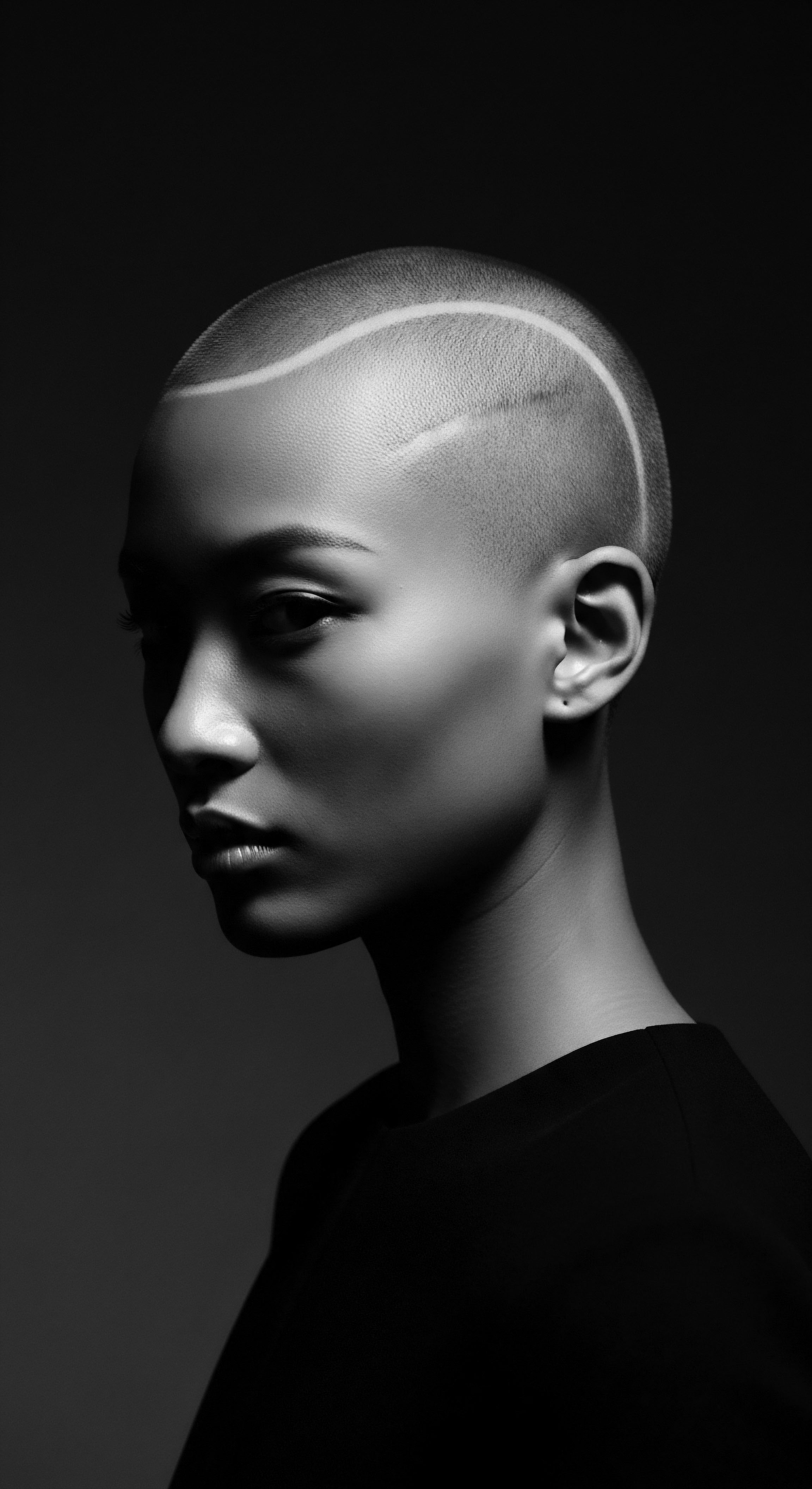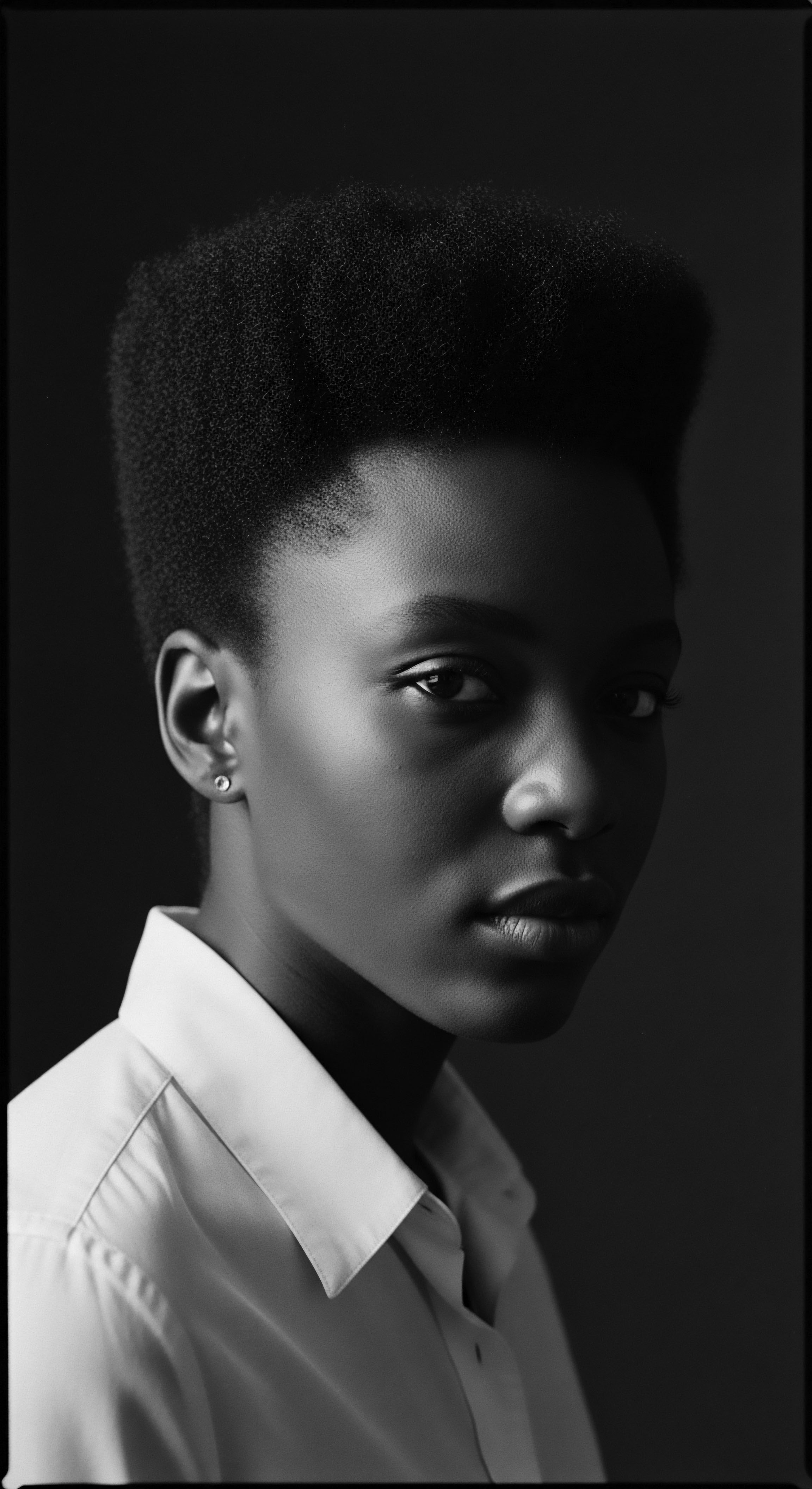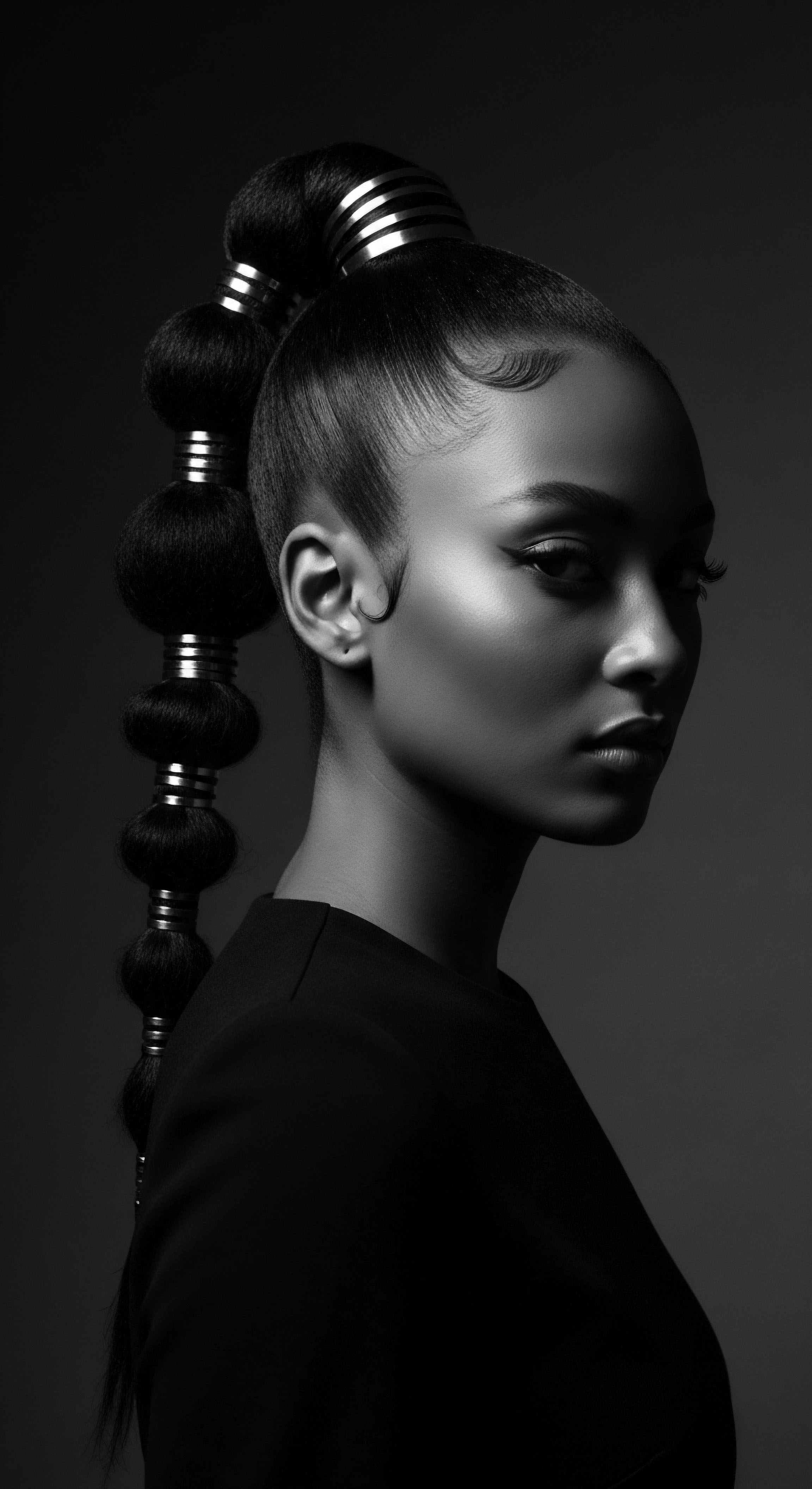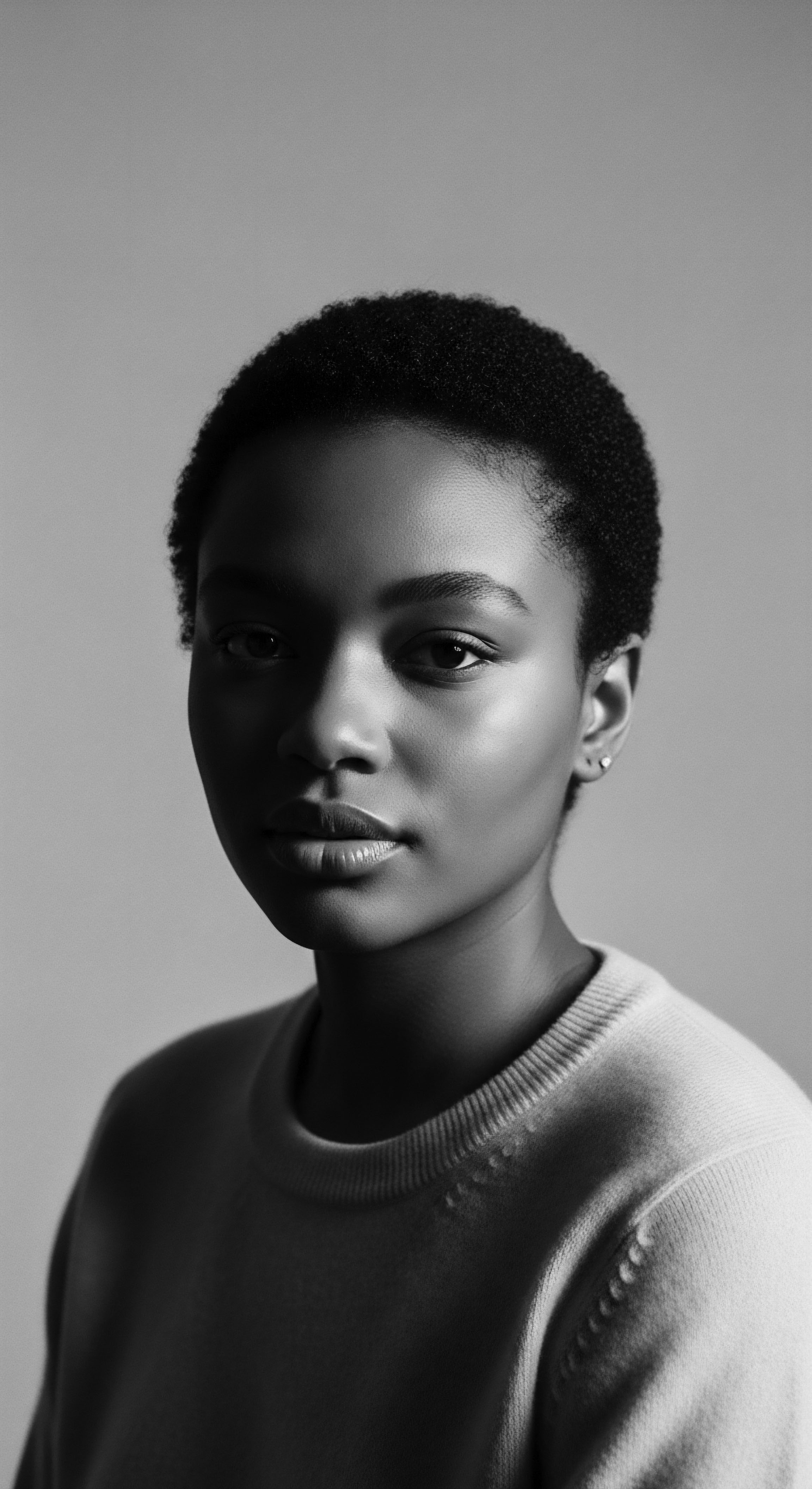
Roots
Consider for a moment the very strands that spring from your scalp, each a testament to generations. These are not merely fibers; they are living archives, holding whispers of ancient suns, ancestral hands, and stories untold. When we speak of hair, particularly textured hair, we are speaking of lineage, of resilience woven into every curve and coil. This heritage of coily, kinky, and curly hair is rich, vibrant, and carries a unique biological signature.
Our journey begins by asking a question that stretches back through time ❉ Did the metallic dyes of old, those compounds born of earth’s minerals, leave their mark on these cherished strands? How did they interact with the very structure of textured hair, a structure often inherently more delicate, yet powerfully symbolic? This inquiry is not simply about chemistry; it is about understanding how past practices shaped the journey of textured hair through centuries, affecting not just its appearance, but its health and its place in communal wisdom.

Understanding Textured Hair’s Ancestral Blueprints
Textured hair, in its myriad forms across Black and mixed-race communities, possesses a distinct anatomical and physiological makeup. Unlike straight hair, which often boasts a round cross-section, coily strands typically present an elliptical or flattened shape. This morphological difference contributes to the characteristic curl pattern, but it also creates inherent points of vulnerability.
The helical shape of textured hair means that the cuticle, the protective outermost layer composed of overlapping flat cells, does not lie as smoothly or tightly as on straight hair. These lifted cuticles, along with varying diameters along the hair shaft, can render textured hair more susceptible to mechanical damage and moisture loss.
From an ancestral perspective, communities developed intricate care practices to honor and protect this unique hair. These traditional methods, passed down through oral histories and lived experiences, recognized the hair’s need for gentle handling, deep conditioning, and protective styling long before modern science articulated the precise mechanisms. The understanding was intuitive, born of observation and a deep connection to natural rhythms. Ancient peoples often relied on what was readily available from their environment, leading to the use of both natural plant-based colorants and, in some instances, mineral compounds.
The journey to understand ancient metallic dyes on textured hair begins by acknowledging the distinct, yet resilient, biological architecture of coily and curly strands.

Early Pigments and the Hair’s Chemistry
The earliest records of human hair coloring stretch back to the Palaeolithic period, with archaeological evidence suggesting the use of reddish Iron Oxide from dirt for adornment, including on hair. As civilizations flourished, particularly in ancient Egypt and Mesopotamia, the desire to alter hair color persisted. Henna, derived from the Lawsonia inermis plant, was a widely used natural dye, known for imparting reddish-brown hues and even black shades when combined with indigo. These plant-based dyes worked by coating or partially penetrating the cuticle layers without necessarily causing structural changes to the hair fiber.
However, alongside these organic substances, mineral compounds also came into play. The Romans, for instance, are known to have experimented with mixtures containing Lead Oxide and Calcium Hydroxide to achieve black hair. Silver nitrate also found its application, particularly in the 19th century, used by men to darken gray facial hair, resulting in a black-brown color that could turn purple with repeated use. These metallic compounds interacted with the hair’s natural keratin proteins.
The keratin protein that forms the hair fiber is rich in Cysteine, an amino acid containing sulfur. It is these sulfur-containing groups (specifically thiol groups) that often interact with metal ions. When metallic salts are applied to hair, they can react with the sulfur in the keratin, forming metallic sulfides within the hair shaft.
For example, lead salts can deposit Lead Sulfide, and silver nitrate can deposit Silver Sulfide, which are dark-colored compounds. This process could effectively change the hair’s color, often gradually, giving the illusion of a more natural darkening.
- Henna ❉ A plant-based dye from Lawsonia inermis, providing red to brown tones, and used with indigo for darker shades.
- Lead Oxide ❉ A mineral compound often mixed with calcium hydroxide, employed by Romans for black hair.
- Silver Nitrate ❉ Used historically to darken hair to brown-black, with repeated application potentially turning hair purple.

Ritual
The act of adorning hair, of changing its shade to suit desire or decree, is a thread woven deeply into the collective human story. For communities with textured hair, this practice was often imbued with layers of cultural significance, signaling status, marital state, or spiritual connection. Hair was, and remains, a powerful visual language.
While many ancestral hair traditions centered on nurturing the hair using plant oils, herbal infusions, and natural dyes like henna, the historical record also shows the occasional intersection with metallic preparations. How did these metallic applications fit into such care rituals, and what might have been their lived consequences for the unique needs of textured hair?

Cultural Expressions Through Color
From ancient Egypt, where black hair signified nobility, to Roman society where prostitutes were mandated to wear yellow hair, altering hair color carried social weight. For communities whose hair naturally possessed darker hues and complex textures, the desire for color change often meant enhancing existing deep tones or camouflaging greying strands. Traditional dyeing practices in the Middle East, for example, leaned heavily on henna, celebrated not only for its reddish tint but also its conditioning properties that strengthen hair by binding to keratin. This underscores a core ancestral wisdom ❉ beauty and well-being were often intertwined.
However, the historical landscape is also dotted with accounts of metallic compounds being used for hair coloring, particularly for achieving dark, lasting shades. Romans and Greeks, for instance, utilized lead oxide and calcium hydroxide to achieve black hair. These early metallic dyes were often applied as pastes, sometimes rubbed onto the head, or even through contact with combs made of lead steeped in vinegar. The gradual nature of these metallic dyes meant repeated application, a process that could unfold over several days or weeks to achieve the desired depth of color.

Did Metallic Dyes Alter Hair Rituals?
The slow, progressive nature of metallic dyes might have integrated into existing hair care routines, perhaps as a weekly application rather than a sudden, dramatic shift. This differs from many plant-based dyes which could offer more immediate results. However, the very chemistry of metallic dyes hinted at challenges for textured hair. Given its inherent predisposition to dryness and mechanical damage, any substance that could further compromise its structural integrity would present a significant concern.
Ancient practices involving metallic dyes, while offering desired shades, potentially introduced novel challenges to the care rituals of textured hair, traditionally centered on preserving its unique vitality.
Consider the particular vulnerability of textured hair ❉ its helical shape and flattened cross-section mean that the cuticle layers, which serve as the hair’s protective armor, are not as uniformly smooth as those on straight hair. This structural characteristic makes textured hair more prone to mechanical stress and breakage. When metallic salts interact with the keratin, they deposit within the cuticle and cortex, potentially causing the hair cuticle to swell. While this might initially give an illusion of thicker hair, the underlying structure could become compromised, leading to weakened inner integrity.
A case study reported in a 2015 FDA report details a 66-year-old man who experienced “hypotrichosis, metal poisoning, and increased blood pressure” after using a lead-containing Grecian Formula cream, a modern iteration of these ancient metallic dye principles. While this example comes from a more recent period, it illuminates the potential health and hair effects of lead-based formulations. (U.S. FDA, 2015, as cited in Breast Cancer Prevention Partners, 2017).
This suggests that the concerns about metallic dyes are not mere speculation but are backed by observations of adverse reactions even in later formulations. For ancestral communities, without modern scientific understanding, the connection between such applications and subsequent hair or health issues might have been perceived through observation of hair changes or unexplained ailments.
The long-term effects of metallic deposits in hair include increased dryness, brittleness, and a greater propensity for breakage and split ends. For textured hair, already prone to these concerns, the impact could have been amplified. The cultural desire for certain aesthetics, achieved through these metallic applications, might have inadvertently led to a cycle of hair damage that required even more diligent and skilled traditional care to mitigate. The delicate balance between cultural expression and hair well-being was a constant negotiation.

Relay
The journey of understanding how ancient metallic dyes affected textured hair requires a deeper scientific exploration, connecting the elemental world to the intricate biology of the strand. This is a complex interplay, where the subtle chemical reactions of millennia past echo in the present-day scientific understanding of hair fiber health. What precise mechanisms caused metallic dyes to leave their mark, and how did textured hair’s unique architecture interact with these chemical transformations?

Chemical Interactions on Hair Fibers
Hair is primarily composed of Keratin, a robust fibrous protein rich in cysteine amino acids. These cysteine residues form disulfide bonds, which are crucial for the hair’s strength, shape, and overall mechanical integrity. Metallic dyes, especially those containing lead, silver, and copper salts, operate by reacting with the sulfur atoms within these keratin proteins. When applied, these metallic ions form insoluble metallic sulfides directly within the hair shaft, effectively depositing color.
For instance, lead acetate reacts to form lead sulfide, while silver nitrate produces silver sulfide. This deposition gives the appearance of a dark color, often a brown-black shade.
The progressive nature of these dyes, where color deepens with repeated applications, meant a gradual buildup of these metallic deposits. This continuous accumulation could lead to a ‘blocking’ of the hair cuticle, swelling it, and giving a temporary sense of increased thickness. However, beneath this superficial change, the internal structure of the hair could be weakening. The interaction of metals with keratin’s thiol groups (from cysteine) can disrupt the protein matrix, altering the hair’s natural elasticity and tensile strength.
Consider the distinctions between plant-based and metallic dyes.
| Dye Type Plant-Based (e.g. Henna) |
| Primary Mechanism Coats or partially penetrates cuticle. |
| Interaction with Hair Keratin Binds to keratin, forms protective layer. |
| Potential Hair Impact Generally conditioning, enhances shine; minimal structural change. |
| Dye Type Metallic Salts (e.g. Lead, Silver) |
| Primary Mechanism Reacts with sulfur in keratin, forms metallic sulfides within hair shaft. |
| Interaction with Hair Keratin Deposits insoluble compounds internally; can swell cuticles, disrupt protein bonds. |
| Potential Hair Impact Can lead to dryness, brittleness, unpredictable color results, interference with future treatments. |
| Dye Type The inherent difference in how dyes interacted with hair fundamentally shaped the long-term health outcomes for ancient hair practices. |

How Did Textured Hair Respond to Metallic Dyes?
The unique morphology of textured hair, with its high curvature and elliptical cross-section, makes it more susceptible to damage than straight hair. Each curve represents a point of potential weakness, where the hair fiber is thinner, increasing the risk of breakage. Additionally, textured hair often possesses fewer cuticle layers than other hair types, meaning less natural protection for the inner cortex.
When metallic dyes were applied to textured hair, these inherent vulnerabilities could be exacerbated. The swelling of the cuticle, induced by the metallic salts, might have further compromised the hair’s delicate outer shield. The disruption of keratin bonds by metal ions could diminish the hair’s natural elasticity, leaving it more brittle and prone to snapping, particularly during everyday grooming which already subjects textured hair to considerable mechanical stress.
Consider also the difficulty in removing metallic dyes once applied. They tend to be long-lasting and are only truly lost as the hair grows out and sheds naturally. This means that any damage incurred would be persistent, building up with each reapplication. The historical record, while not always explicit about textured hair experiences, hints at complications.
Accounts from ancient Greece describe methods of darkening gray hair with wood ashes and lye soap, a caustic process that could cause skin burns and hair fall. While not strictly metallic, this illustrates the lengths to which people went, and the potential for severe damage from harsh chemical treatments.
The impact was not only structural but could also affect subsequent hair treatments. Metallic deposits in hair can react adversely with modern chemical processes such as perms or other hair colorings, leading to unpredictable color shifts (e.g. green or purple hues), excessive heat generation, or even hair dissolution in severe instances. While ancient peoples lacked modern salon chemistry, it is plausible that attempting to alter hair that had been treated with metallic dyes using other traditional methods (perhaps a new plant-based blend or an alkaline wash) could have yielded unexpected or detrimental results.

Were There Ancestral Safeguards?
Ancestral wisdom, deeply rooted in holistic wellness, often countered potential harm with preventative and restorative practices. Middle Eastern haircare, for instance, relied on natural oils like argan and sweet almond oil for nourishment and protection. These oils, rich in fatty acids and vitamins, would have provided a protective barrier and helped maintain moisture, potentially mitigating some of the drying effects of metallic dyes. Scalp massages and the use of herbal infusions were also common, promoting overall scalp health which is foundational to robust hair growth.
However, despite these nurturing rituals, the fundamental chemical interaction of heavy metals with hair keratin remains a potent force. The unique cellular architecture of textured hair, already navigating its own inherent fragility, would have faced a significant challenge from the long-term presence of these metallic deposits. The subtle shift in elasticity, the gradual increase in brittleness, and the dulling of natural vibrancy would have represented a silent burden on these cherished strands, a testament to the enduring quest for aesthetic expression, sometimes at a cost.
- High Curvature ❉ Increases the hair’s susceptibility to mechanical damage at bends.
- Elliptical Cross-Section ❉ Contributes to the hair’s unique shape but can mean less cuticle integrity.
- Fewer Cuticle Layers ❉ Offers less inherent protection to the internal cortex compared to other hair types.

Reflection
As we return from this exploration of ancient metallic dyes and their historical resonance with textured hair, a profound appreciation for our hair’s living lineage deepens. The question of whether these old-world compounds damaged textured hair finds its answer not merely in scientific mechanisms, but in the echoes of ancestral practices and the enduring spirit of our strands. The wisdom passed through generations, emphasizing natural oils, gentle handling, and protective styles, stands as a testament to an intuitive understanding of hair health, even in times when the chemistry was not fully deciphered. This inherited knowledge, often expressed through the tender care of a mother braiding her child’s coils or a community gathering for shared grooming rituals, represents a profound connection to wellbeing.
Our textured hair, in its vibrant diversity, continues to tell a story of resilience and adaptation. It carries within it the memory of every challenge, every innovation, every choice made in the pursuit of beauty and identity throughout history. The metallic dyes of antiquity, while offering certain aesthetic outcomes, also presented a unique test to the intrinsic qualities of coily and curly hair. This historical interplay reminds us that true radiance stems from a place of deep respect for our hair’s natural state and a commitment to nurturing its strength.
Roothea’s ethos calls us to view each strand not just as a fiber, but as a living part of our heritage, deserving of informed, soulful care that honors its past and secures its vibrant future. The journey of our hair is indeed a living archive, always growing, always evolving, yet eternally rooted in its rich, ancestral soil.

References
- Breast Cancer Prevention Partners. (2017). BCPP Petitions FDA to Ban Lead Acetate from Hair Dye.
- Cosmetics & Toiletries. (2020). Defying Damage ❉ Understanding Breakage in Afro-textured Hair.
- Encyclopedia.com. (n.d.). Hair Dyes and Hair Treatments.
- Eazicolor Professional. (2023). Metallic Hair Dye Vs Synthetic Hair Dye.
- Hairfinder. (n.d.). The first colors for hair and the history of hair dye.
- Hexis Lab. (n.d.). Genomic Variation in Textured Hair ❉ Implications for Holistic Hair Care.
- Joanna Colomas. (2023). Unlock Ancient Hair Care Secrets ❉ Discover Global Rituals for Lustrous Locks.
- MDPI. (2023). Mechanisms of impairment in hair and scalp induced by hair dyeing and perming and potential interventions.
- MDPI. (n.d.). Porosity and Resistance of Textured Hair ❉ Assessing Chemical and Physical Damage Under Consumer-Relevant Conditions.
- Oncodaily. (2025). Does Hair Dye Cause Cancer? Myths and Facts.
- Quora. (2018). Did ancient people dye their hair and if so how did they do it?
- Quora. (2024). Did Egyptians invent hair dye?
- ResearchGate. (n.d.). The Chemistry Mechanism of Hair Dyes.
- RSC Education. (2021). The colourful world of hair dye.
- Scribd. (n.d.). History Behind Hair Dye.
- The Arab Today. (2024). Arabian Haircare Rituals ❉ Ancient Secrets for Modern Tresses.
- The People’s Pharmacy. (n.d.). Lead in Hair Dye Is Finally Coming Out!
- Toppik.com. (2016). Middle Eastern and Indian Hair Care Tips.
- VertexAISearch. (n.d.). US6802872B2 – Hairdye composition containing metallic compound.
- WHYY. (2019). Does pretty hurt? A look at the health risks of hair dyes.
